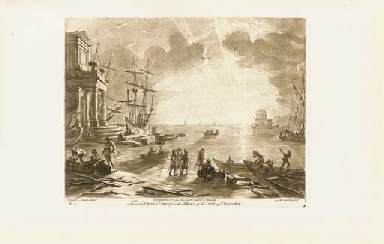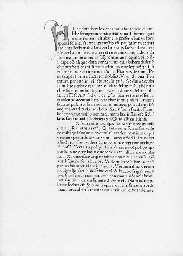OBERBAYERISCHE LANDRECHT OF 1346, in German with Latin headings, and STADTRECHT OF WASSERBURG AM INN, in German, ILLUMINATED MANUSCRIPT ON VELLUM [Bavaria, c.1450-1460] 383 x 290mm. i + 77 leaves: 1-7 1 0, 8 7(of 8, viii cancelled blank, perhaps the leaf at the beginning of the volume), COMPLETE, original foliation of texts in red roman numerals running from the sixth leaf, ff.i-xliii, and from the fifty-third leaf, ff.i-xxv, catchwords at lower edge of final versos, signatures, 37 lines written in black ink in a cursive script between two verticals and 38 horizontals ruled in plummet, justification: 260 x 180mm, headings and two-line initials in red, three-line initials in red, pink, blue or green, text capitals touched red, THREE LARGE INITIALS WITH FOLIATE STAVES EXTENDING INTO BAR BORDERS in green or pink on patterned grounds of red, blue or green, the borders enhanced by disks of burnished gold (some original holes in parchment, some discolouring of margins, section neatly cut from margin of f.74). Contemporary south-German reversed ochre leather over wooden boards, blind intersecting double fillets in saltire, two leather fore-edge tabs, brass cornerpieces with fleurs-de-lys and centrepieces (worn, restorations to spine, lacking two clasps). PROVENANCE: 1. The handsome size, script and illumination suggest that this was not a lawyer's working copy, more usually on paper, but a volume of record to be treasured in a communal or individual library of some significance. Content, language and style show that it was made in Bavaria, perhaps in Wasserburg. 2. Library mark E 20 inside upper cover. CONTENT: Law of Bavaria enacted by Ludwig of Bavaria, the Emperor Louis IV ff.1-48: table of contents with page references, headed in Latin Secundum Ysadorum... , running from Chapter I, Article 1, to Chapter XXVI, Article 342, omitting some articles that do appear in the text ff.1-5v, text, the preamble opening Wir Luedwig von Gotes genaden... , giving the date 1346, ff.6-48v, ending with Chapter XXVIII, Article 350, ...er hab visch funden oder nicht , followed by the oath acceptable from the Jews headed Das ist der Juden ayde , opening Das ersten sol der Jud... and ending ...Moysi auf dem perg Synay ; Law of Wasserburg am Inn, taken from the Town Law of Munich, headed Incipiunt iura specialia magis propria civitatis Monaci et Wasserburg ff.49-77: table of contents ff.49-52, text opening Was hinder sechs und dreissigk pfennig. Swer hinter dem andern gelt... and ending ...ob sy weelent recht , the 236 articles numbered by a later hand in the margin, ff.52-77v. The Bayersiche Landrecht of 1346 was enacted by Ludwig, Markgrave of Brandenburg, with his brothers Stephen, Ludwig (later Elector of Brandenburg) and William (Count of Hainualt, Holland and Zeeland), Dukes in Bavaria, with the authority of their father Ludwig IV, the Emperor. There is a modern edition of the original text, Munich, Stadtarchiv, Zimelie 12, by H. Schlosser and I. Schwab, Oberbayerische Landrecht Kaiser Ludwigs von Bayern von 1346 , 2000. This manuscript conforms to that closely and, as is usual, omits clause 184a, Umb die Iuden , on dealings between Jews and Christians, which was erased in Zimelie 12. The final section on the Jewish oath comes not from the Landrecht but the Munich Stadtrecht, where the same text is found as Article 298 in the Ratsbuch of c.1315 (P. Dirr, Denkmäler des Münchner Stadtrechts, I, 1158-1403 , 1932-4, pp.285-6; see V. Zimmermann, Die Entwicklung des Judeneides , 1973, pp.153-8 ). Munich had become the capital of Bavaria under Ludwig II in the 13th century. In 1340 the Bavarian Dukes under their father, the Emperor, enacted the town law in 193 articles that remained fundamental: the first additions in 1347 were made to the original manuscript. Dirr published the 1340 code, the 1347 additions, articles 194-202, and those in the Liber Rufus of 1365, Articles 203-611; later additions appear in F. Auer, Das Stadtrecht von München nach
OBERBAYERISCHE LANDRECHT OF 1346, in German with Latin headings, and STADTRECHT OF WASSERBURG AM INN, in German, ILLUMINATED MANUSCRIPT ON VELLUM [Bavaria, c.1450-1460] 383 x 290mm. i + 77 leaves: 1-7 1 0, 8 7(of 8, viii cancelled blank, perhaps the leaf at the beginning of the volume), COMPLETE, original foliation of texts in red roman numerals running from the sixth leaf, ff.i-xliii, and from the fifty-third leaf, ff.i-xxv, catchwords at lower edge of final versos, signatures, 37 lines written in black ink in a cursive script between two verticals and 38 horizontals ruled in plummet, justification: 260 x 180mm, headings and two-line initials in red, three-line initials in red, pink, blue or green, text capitals touched red, THREE LARGE INITIALS WITH FOLIATE STAVES EXTENDING INTO BAR BORDERS in green or pink on patterned grounds of red, blue or green, the borders enhanced by disks of burnished gold (some original holes in parchment, some discolouring of margins, section neatly cut from margin of f.74). Contemporary south-German reversed ochre leather over wooden boards, blind intersecting double fillets in saltire, two leather fore-edge tabs, brass cornerpieces with fleurs-de-lys and centrepieces (worn, restorations to spine, lacking two clasps). PROVENANCE: 1. The handsome size, script and illumination suggest that this was not a lawyer's working copy, more usually on paper, but a volume of record to be treasured in a communal or individual library of some significance. Content, language and style show that it was made in Bavaria, perhaps in Wasserburg. 2. Library mark E 20 inside upper cover. CONTENT: Law of Bavaria enacted by Ludwig of Bavaria, the Emperor Louis IV ff.1-48: table of contents with page references, headed in Latin Secundum Ysadorum... , running from Chapter I, Article 1, to Chapter XXVI, Article 342, omitting some articles that do appear in the text ff.1-5v, text, the preamble opening Wir Luedwig von Gotes genaden... , giving the date 1346, ff.6-48v, ending with Chapter XXVIII, Article 350, ...er hab visch funden oder nicht , followed by the oath acceptable from the Jews headed Das ist der Juden ayde , opening Das ersten sol der Jud... and ending ...Moysi auf dem perg Synay ; Law of Wasserburg am Inn, taken from the Town Law of Munich, headed Incipiunt iura specialia magis propria civitatis Monaci et Wasserburg ff.49-77: table of contents ff.49-52, text opening Was hinder sechs und dreissigk pfennig. Swer hinter dem andern gelt... and ending ...ob sy weelent recht , the 236 articles numbered by a later hand in the margin, ff.52-77v. The Bayersiche Landrecht of 1346 was enacted by Ludwig, Markgrave of Brandenburg, with his brothers Stephen, Ludwig (later Elector of Brandenburg) and William (Count of Hainualt, Holland and Zeeland), Dukes in Bavaria, with the authority of their father Ludwig IV, the Emperor. There is a modern edition of the original text, Munich, Stadtarchiv, Zimelie 12, by H. Schlosser and I. Schwab, Oberbayerische Landrecht Kaiser Ludwigs von Bayern von 1346 , 2000. This manuscript conforms to that closely and, as is usual, omits clause 184a, Umb die Iuden , on dealings between Jews and Christians, which was erased in Zimelie 12. The final section on the Jewish oath comes not from the Landrecht but the Munich Stadtrecht, where the same text is found as Article 298 in the Ratsbuch of c.1315 (P. Dirr, Denkmäler des Münchner Stadtrechts, I, 1158-1403 , 1932-4, pp.285-6; see V. Zimmermann, Die Entwicklung des Judeneides , 1973, pp.153-8 ). Munich had become the capital of Bavaria under Ludwig II in the 13th century. In 1340 the Bavarian Dukes under their father, the Emperor, enacted the town law in 193 articles that remained fundamental: the first additions in 1347 were made to the original manuscript. Dirr published the 1340 code, the 1347 additions, articles 194-202, and those in the Liber Rufus of 1365, Articles 203-611; later additions appear in F. Auer, Das Stadtrecht von München nach















Try LotSearch and its premium features for 7 days - without any costs!
Be notified automatically about new items in upcoming auctions.
Create an alert